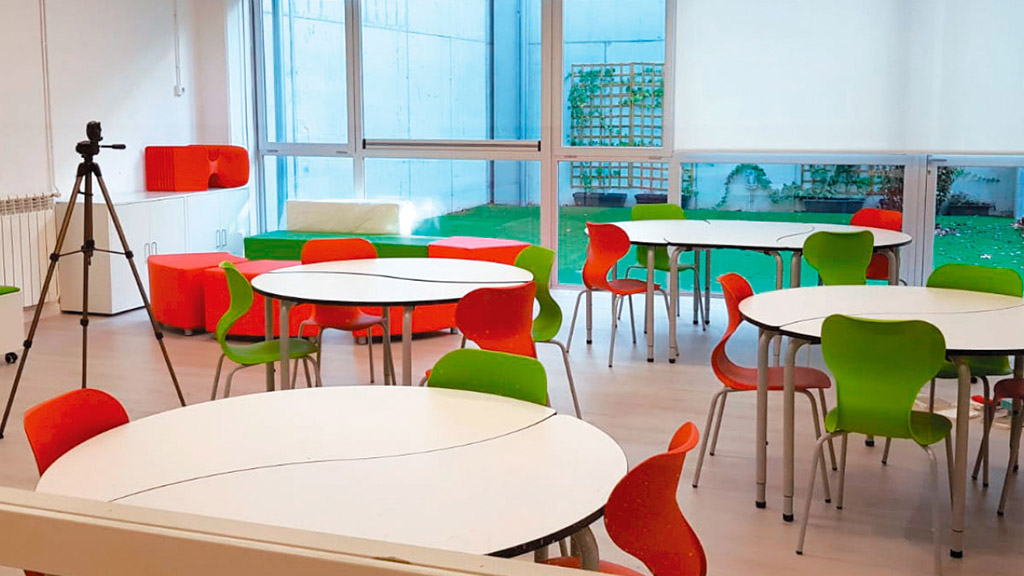What should classrooms and virtual environments look like when the schools go back?
UOC researchers coordinate a project that rethinks learning spaces
With the end of the lockdown, workplaces, shops, entertainment facilities and even beaches are being adapted to comply with prevention measures to reduce the risk of SARS-CoV-2 contagion. This also includes schools, something that researchers on the Universitat Oberta de Catalunya (UOC) Smart Classroom Project have been analysing, and they’ve come up with ten educational commandments for respecting hygiene rules and social distancing.
“They’re designed to bring about reflection on how we understand the learning space in schools at any level, from pre-school to university, and how we can adapt it in these exceptional – and, hopefully, temporary – circumstances,” explained Guillermo Bautista, project member and professor at the UOC Faculty of Psychology and Education Sciences.
Amongst other measures, the researchers propose teaching students to use the space, that is, explaining to them the importance of respecting distances and hygiene rules but without losing relationship customs and interpersonal contact (for example, greeting each other using their elbows).
More space and visual contact
In this regard, the researchers suggest clearing the space by removing furniture and using areas that were not previously used for learning (corridors, tutoring rooms, porches and yards). Table layout should preferably be in a circle or semicircle in groups to facilitate visual contact between students and with teachers, all of whom should use masks above a certain age.
“Masks mean an important part of interpersonal communication, facial expression and non-verbal communication is lost; that’s why it’s important to use your hands to gesture and highlight the expression of feelings and emotions along with verbal language,” said Bautista. In this respect, the researchers propose fostering visual connection by leaving doors open and removing physical barriers.
In the classroom, this decalogue advocates students working independently, encouraging them to ask questions and reflect, while keeping safe distances. Teachers can divide the class into groups and go over doubts with each of them separately.
To prevent crowding, entry and exit times will have to be staggered, as will break times. “From the youngest to the oldest children, the key is to create, little by little, a culture of use of space adapted to current needs,” said Bautista. In this new scenario it will be essential to foster student comfort and controlled movement.
Classroom and online education
In regard to teaching tools, the researchers propose using devices such as tablets or portable desks, so that students can work anywhere. The decalogue’s authors advocate blended learning, both in the classroom and online, incorporating the use of digital technology as a day-to-day educational practice.
“Ideally, we should balance online work so as not to overload teachers or students, and classroom time that fosters communication and dialogue, as well as tasks that are most difficult to carry out alone at home,” said Bautista.
This means the children having digital access both in the classroom and at home, which is not always possible. “This is something that should concern the Administration, because, even though teachers and schools are ready for this, these proposals will be of no use if the students do not have access to these devices,” he stressed.
The Smart Classroom Project researchers also advise taking advantage of this new situation to foster students’ self-regulation; that is, teachers help, moderate and supervise, but the students learn by themselves and develop self-regulation skills. This means that they take responsibility for much of the learning process.
A new type of learning, beyond the pandemic
Although the measures came about in the context of the current pandemic, the authors also think they will serve when the health crisis is over. “This need to rethink the space can also be a good opportunity to rethink our approach to learning, so this reflection serves not just as a response to the current emergency,” said Bautista.
The Smart Classroom Project is one of the finalists of SpinUOC 2020, an annual entrepreneurship programme promoted by the UOC’s Hubbik platform, the final of which is set to take place on 1 October. Along with Guillermo Bautista, the team consists of University of Barcelona professors Anna Escofet and Marta López, and María Casanovas, professor and technical advisor on education and learning space design.
The Universities and Research Department in the Government of Catalonia's Ministry of Business and Knowledge has given the green light to funding for the Smart Classroom project as part of its Innovators 2019 programme, which receives funding from the European Regional Development Fund (ERDF). The programme looks to transfer knowledge and generate value from the projects developed by innovators spending time at Catalan research and innovation centres.
UOC R&I
The UOC's research and innovation (R&I) are helping 21st-century global societies to overcome pressing challenges by studying the interactions between ICT and human activity, with a specific focus on e-learning and e-health. Over 400 researchers and 48 research groups work among the University's seven faculties and three research centres: the Internet Interdisciplinary Institute (IN3), the eLearn Center (eLC) and the eHealth Center (eHC).
The United Nations' 2030 Agenda for Sustainable Development and open knowledge serve as strategic pillars for the UOC's teaching, research and innovation. More information:research.uoc.edu.


Experts UOC
Press contact
-
Editorial department
